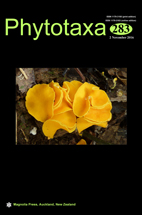Abstract
Among 46 species of Premna Linnaeus (1771: 587) recognized in the Flora of China (Chen & Gilbert 1994), P. yunnanensis Smith (1916: 120) and 13 more species form a well supported monophyletic group (Li et al. 2016) assigned to ser. Congestiflorae P’ei & Chen (1982: 211), under sect. Premnos Briquet (1897: 170). Congestiflorae is characterized by having cymes in a dense capitate inflorescence, leaves and calyces densely covered with golden, orange or red glands, and calyces with five long distinct calyx-lobes. The 14 species are all endemic to southwest China, particularly to Yunnan and Sichuan provinces. Premna yunnanensis is the most widespread, occurring throughout the north of Yunnan and southwest of Sichuan (P’ei & Chen 1982, Chen & Gilbert 1994). This species is characterized by having ovate-lanceolate to ovate leaves, abaxially densely gray circinate pilose, pinkish to purple corolla, and fruiting calyces equal or subequal to fruits (Fig. 1). However, while examining herbarium specimens, it is found that the types of P. anthopotamica Handel-Mazzetti (1921: 231) (Fig. 2B), P. parvilimba P’ei (1932: 62) (Fig. 2C), P. pilosa P’ei (1932: 66) (Fig. 2D), P. steppicola Handel-Mazzetti (1936: 902) (Fig. 2E) and P. subcapitata Rehder (1917: 458) (Fig. 2F) are morphologically very similar to P. yunnanensis. Further critical qualitative and quantitative examination of more herbarium specimens—including types- (from A, CBDI, E, HITBC, IBK, IBSC, KUN, NAS, NY, PE, W and WU herbaria), living plants (field explorations in Yunnan and Sichuan during 2010 and 2014), and protologues, do not support the distinction of these species from P. yunnanensis. Furthermore, geographical analysis reveals that the type locality of each species is encompassed in the natural distribution of P. yunnanensis. Thus, P. anthopotamica, P. parvilimba, P. pilosa, P. steppicola and P. subcapitata are determined as conspecific with P. yunnanensis.

